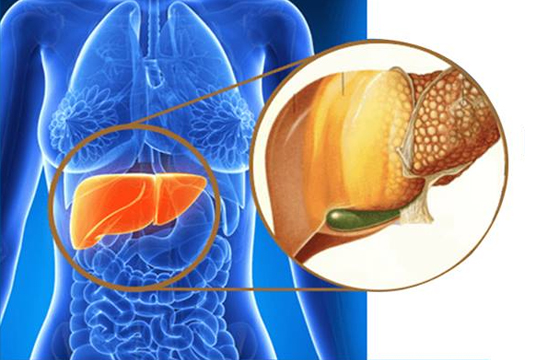What are the symptoms of Fatty Liver?
Fatty liver typically has no associated symptoms. However, research has shown that about 20 percent of people with fatty liver inflammation progress to worse conditions. If this occurs you may experience fatigue or abdominal discomfort. Your liver may become slightly enlarged, which your doctor may be able to detect during a physical exam.
It’s believed that the excess fat in the liver, along with certain medical conditions, increases inflammation. If your liver becomes inflamed, you may have symptoms such as:
• a poor appetite
• weight loss,
• abdominal pain
• physical weakness,
• fatigue
• confusion
If fatty liver progresses to cirrhosis and liver failure, symptoms can include:
• an enlarging, fluid-filled abdomen
• jaundice of the skin and eyes
• confusion
• abnormal bleeding

What causes of Fatty Liver?
The most common cause of fatty liver is alcohol use disorder and heavy drinking. In many cases, it’s much less clear what causes fatty liver in people who don’t drink much alcohol. However, higher body weight, a high processed sugar diet, high triglycerides, diabetes, low physical activity, and genetics all play a role.
Fatty liver develops when the body creates too much fat or cannot metabolize fat efficiently enough. The excess fat is stored in liver cells where it accumulates and causes fatty liver disease.
Besides alcohol use disorder, other common causes of fatty liver include:
• Obesity
• Hyperlipidemia, or high levels of fats in the blood, especially high triglycerides
• Diabetes
• Genetic inheritance
• Rapid weight loss
• Side effects of certain medications, including methotrexate (Trexall), tamoxifen (Nolvadex), amiodorone (Pacerone), and valproic acid (Depakote)
Who is at Risk for Fatty Liver?
Fatty liver is the buildup of extra fats in the liver. It’s more likely to develop if you’re overweight or obese. Having type 2 diabetes also may increase your risk for fatty liver. Fat accumulation in the liver has been linked to insulin resistance, which is the most common cause of type 2 diabetes.
Other factors that may increase your risk for fatty liver include:
• Excessive alcohol use
• Taking more than the recommended doses of certain over-the-counter medications, such as acetaminophen (Tylenol)
• Pregnancy
• High cholesterol
• High triglyceride levels
• Malnutrition
• Metabolic syndrome
• Low physical activity
Diagnosis
1) Physical Exam:
If your liver is inflamed, your doctor may be able to detect it by examining your abdomen for an enlarged liver. However, your liver can be inflamed without being enlarged. Let your doctor know if you’ve been experiencing fatigue or loss of appetite. Also, tell your doctor about any history of alcohol, medication, and supplement use.
2) Blood Tests:
Your doctor may find that liver enzymes are higher than normal during a routine blood test. This doesn’t confirm a diagnosis of fatty liver, but it does relate to liver inflammation. Further analysis is necessary to find the cause of the inflammation.
3) Imaging Studies:
Your doctor may use an ultrasound to detect fat in your liver. Other imaging studies may also be done, such as CT or MRI scans. Another imaging test similar to ultrasound is a FibroScan. Like an ultrasound, a FibroScan utilizes sound waves to determine the density of the liver and the corresponding areas of fat and normal liver tissue. Imaging studies can detect fat in the liver, but they cannot help your doctor confirm the extent of damage.
4) Liver Biopsy:
A liver biopsy is still considered the best way to determine the severity of liver disease. During a liver biopsy, your doctor will insert a needle into the liver and remove a piece of tissue for examination. They will give you a local anesthetic to lessen the pain. A liver biopsy is the only way to know for certain the severity of fatty liver or other liver diseases. The biopsy can also help your doctor determine the exact cause.
Treatment
Physical Exam:
Research is ongoing into medications that may help treat fatty liver. The first-line of treatment continues to be following recommendations to reduce your risk factors. These recommendations typically include:
• Limiting or avoiding alcoholic beverages
• Managing your cholesterol and reducing your intake of sugars and saturated fats
• Losing weight
• Controlling your blood sugar
If you have fatty liver because of obesity or unhealthy eating habits, your doctor may also suggest that you increase physical activity and eliminate or add certain types of foods to your diet. Reducing the number of calories you eat each day can help you lose weight and heal your liver.
In the early stages, you can improve and reverse fatty liver disease by reducing or eliminating fatty foods and foods high in sugar from your diet. Choose a balanced diet with healthier foods such as fresh fruits, fresh vegetables, whole grains, and healthy fats like those in nuts and avocados. Replace red meats with lean proteins such as soy, chicken, turkey, and fish. Sweetened drinks, juices, and sodas should be avoided.
Prevention
Protecting your liver is one of the best ways to prevent fatty liver and its complications. You can start by taking several steps:
• Limit or eliminate alcohol from your diet
• Eat a healthy, balanced diet
• Control diabetes if you have developed the condition
• Aim for at least 30 minutes of exercise most days of the week
By taking these steps, you’ll not only keep your liver healthy but also improve your overall health.


